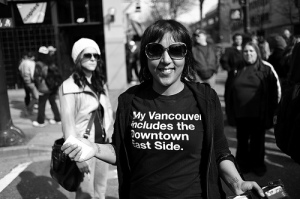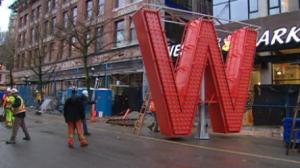The Pidgin buzz has died since the photo-op began a few weeks ago, but the issues and the conflict are at the forefront of the next great debate surrounding the eastside. How do we develop it responsibly?
There’s something brewing. From the restaurants to multi-million dollar SRO renovations to condo developments, the neighbourhood has entered a new phase that began with the renovation of the Woodward’s building and the introduction of idea of the “social mix”.
This has not been without considerable controversy. Pidgin is being picketed, SROs are raising rents and shutting out welfare residents while dealing with significant quality of life issues and housing developments have become the battleground for business interests intersecting with those who would rather see more social housing.
The buzzword, gentrification, is old but the conversation is new, all these issues have blossomed after the Olympics. Far from another feature of how bleak the downtown eastside is (although when Atira CEO Janice Abbott mentions sewage flooding up through the waterpipes…), this is the topic of what happens with this neighbourhood when money is thrown at it. What is bringing businesses and condos in doing to the downtown eastside?
○ The provincial government has announced a $143 million project to renovate the interior of the 13 SRO hotels they own in the downtown eastside. This work is mainly to bring the buildings up to code, some of which are listed in the city of Vancouver’s new online database of buildings with health or safety issues. The first hotel to receive renovation will be the Marble Arch, cited in a September report from CBC for it’s appalling structural and social conditions.
When I asked Janice Abbott just how bad these buildings were, she shook her head and described buildings with heavy structural damage, single bathrooms that were servicing the entire floor, plumbing that was almost 100 years old and barely staying together and other such issues that most would find shocking and appalling if they were occurring in any other neighbourhood in Vancouver.
○ Its proximity to Gastown, Waterfront Station and the cruise ship docks in conjunction with the cheapest rent in town has made a new hotbed for culinary establishments. The recent picketing of Pidgin is slightly curious for the fact that it is far from the first restaurant in town. There’s Calabash, Cartems, Acme, Bitter and Rainer Provisions just off the top of my head. The grandaddy is Save-On-Meats, for whom I am currently employed. Far from being a strictly capitalist venture, Save-On-Meats has contracts to produce nearly 500 meals a day for SRO residents while branding a sandwich token program that will shortly be expanded to include socks and has been spun-off in Toronto. This is the genesis of the other buzzword in play, social entrepreneurship. As Colleen Kimmett noted on The Tyee last year, a study of 911 calls to SRO residences after the implementation of a meal program found a 25 to 33 per cent decrease. What does entrepreneurship do to the eastside? What about social entrepreneurship?
○ The physical condition of SROs notwithstanding, these buildings are increasingly being priced above the welfare shelter rate of $375, forcing those on welfare to pay out of their own pockets to make up the difference, leaving very little money left for anything else. Increasingly, these raises are done to attract people who are either working in the neighbourhood or students and cannot afford elsewhere. Those most in need of social housing are increasingly being shunned.
○ There is a need for the idea of building social spaces for downtown eastside residents. As Janice Abbott noted, having nothing to do in a tiny SRO room with little resources available breeds problems. I remember a conversation I had with a co-worker last year who lived above The Bourbon and was admitting his addiction to painkillers. He mentioned that since he worked in the evenings at the restaurant, he would wake up with nothing to do for hours. Without many options for structure, he found himself increasingly going out to the street and buying drugs to kill time until he had to work. I encouraged him to find a hobby and he stated that he had in interest in photography. He saved up to buy a digital SLR camera and now has a few odd jobs taking photographs for Save-On-Meats and those behind the new and improved DNC Street Market, which brings us to our next point..
○ DNC Street Market is new and improved. The infamous makeshift flea market on Carrall St near Pigeon Park now has organization and structure behind it. It soon involve tables and food vendors and much more of a professional feel than the traditional routine of rolling out stolen goods on blankets. Now the stolen goods will be raised above the ground.
○ Ok what else? the “social mix” experiment first promoted with the Woodward’s building and now seen in a number of developments in or around the downtown eastside has been around long enough to measure. The Carnegie Community Action Project, perhaps unsurprisingly, has come out against the social mix, lamenting that in the four years since the Woodward’s building was opened, over 400 SRO rooms in the immediate surrounding area have been closed down or now rent higher than the welfare shelter rate.
It is also very common to talk to people who live in the social housing units at Woodward’s and hear their complaints of segregation. The market units and social units within the building are shut off from each other, with separate entrances and elevators while the businesses of London Drugs and Nester’s are not of much use to low-income residents. The once promised ratio of unit of market housing to one unit of social housing long been thrown out the window. It’s time to take a look at what was called an experiment when it was originally implemented and figure out the quantitative and qualitative results.
Take the 17-storey tower going up at 611 Main St in Chinatown. It will house 134 market units and 22 social housing units for seniors, of which 11 will be rented out at the welfare rate. At the public hearing, downtown eastside advocates argued the building could not go through with so little social units for low-income residents while Chinatown business owners feared that without the injection of middle-income families, Chinatown would soon be a ghost town.
This is the complicated conversation we need to start having about the downtown eastside.




